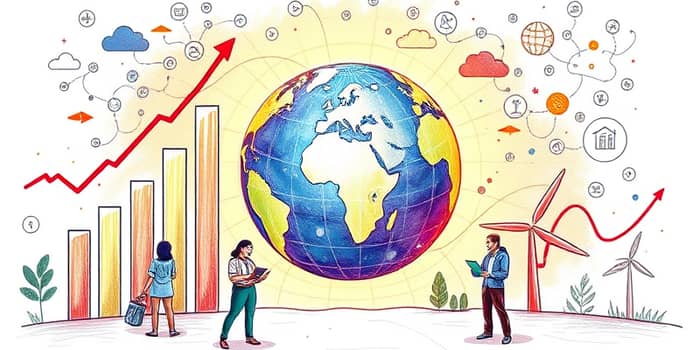As the world navigates a complex post-pandemic landscape, decision-makers and business leaders are challenged to foster sustainable growth. With the International Monetary Fund projecting global GDP growth of 3.0 percent in 2025, and inflation hovering around 4.2 percent, it is vital to understand the forces at play and craft strategies that can thrive anywhere.
Latest Global Economic Outlook
The IMF forecasts world GDP will expand by 3.0 percent in 2025 and 3.1 percent in 2026, while the OECD predicts similar trends of 2.9 percent growth across its members. Emerging markets and developing economies are set to grow at 3.7 percent, compared to 1.4 percent for advanced economies. These figures underscore the shifting dynamics of global output.
Regional performances differ markedly:
While the United States remains the largest economy, its growth has slowed to just 1.1 percent from Q4 2024 to Q4 2025. China faces trade disruptions and structural challenges, while India continues to surge ahead as the fastest growing major economy at up to 7 percent.
Inflation and Policy Environment
Global inflation is projected at 4.2 percent in 2025, easing slightly to 3.6 percent in 2026. The OECD’s estimates are similar, signaling persistent price pressures even as demand moderates. Central banks in many regions contemplate rate cuts, though the U.S. Federal Reserve is expected to hold rates until at least March 2026.
Geopolitical tensions and tariff hikes—such as 50 percent duties on Brazilian imports—introduce rising uncertainty in trade policy. Combined with fiscal expansions in the U.S., euro area, and China, these factors could push public deficits to multi-decade highs, notably in Germany.
Macro Themes and Business Implications
Key themes for 2025 include:
Persisting weakness in investment despite low interest rates, as housing and public infrastructure spending remain subdued. Firms must grapple with more volatile policy environments, requiring agile planning and diversified supply chains.
A slowdown in globalization has increased price volatility, while fiscal and trade policies have become more central than monetary tools. Businesses must now anticipate frequent policy shifts and build resilience accordingly.
Sectoral and Regional Opportunities
Across geographies, different sectors offer unique growth levers:
- United States: Innovation hubs, advanced infrastructure, and strong consumer markets anchor future expansion.
- China: Its manufacturing base and large domestic market offer scale, though structural reforms are needed.
- India: Digital transformation, IT services, and “Make in India” manufacturing are propelling growth.
- Japan: Excellence in automotive, electronics, and robotics keeps it at the technological frontier.
- Europe: Sustainability investments, collective market access, and stable institutions provide competitive advantages.
- Emerging Markets: High long-term potential driven by FDI, domestic consumption, and digitalization, balanced by institutional risks.
Growth Strategies Adaptable to Any Economy
Whether operating in an advanced or developing context, certain strategic pillars remain universal:
- Invest in innovation, digitization, and sustainability to stay ahead of global trends.
- Modernize infrastructure and strengthen logistical networks for higher productivity.
- Develop a skilled workforce equipped for automation and new technologies.
- Embed climate resilience and adaptive strategies to mitigate environmental risks.
- Diversify trade relationships to manage tariff pressures and geopolitical disruptions.
- Encourage public-private partnerships in infrastructure, research, and technology deployment.
For emerging economies, targeted reforms to improve the business climate, investments in education, and digital government and fintech platforms can create leapfrog opportunities. Advanced economies, by contrast, should focus on further automation, sustainable industrial practices, and workforce retraining.
Implementing Change: Practical Steps
Actionable measures include:
1. Conducting regular risk assessments of tariff and policy environments to anticipate shifts.
2. Creating cross-sector coalitions to fund and execute infrastructure projects.
3. Launching digital literacy initiatives to build inclusive, future-ready talent pools.
4. Setting up monitoring frameworks that track key economic indicators—growth rates, inflation, and investment trends—allowing for rapid policy or operational adjustments.
Conclusion
Global growth at 3.0 percent may seem modest, but by leveraging innovation, strengthening policy predictability, and fostering inclusive practices, economies of all sizes can unlock significant potential. The interplay of emerging market dynamism and advanced economy expertise presents a unique opportunity. By adopting these growth strategies—rooted in data and guided by adaptability—nations and businesses alike can navigate uncertainties and emerge stronger in the years ahead.
References
- https://www.imf.org/en/Publications/WEO/Issues/2025/07/29/world-economic-outlook-update-july-2025
- https://www.oecd.org/en/publications/2025/06/oecd-economic-outlook-volume-2025-issue-1_1fd979a8.html
- https://www.morganstanley.com/insights/articles/economic-outlook-midyear-2025
- https://www.cerityglobal.com/blogs/top-15-countries-by-gdp-in-2025/
- https://www.mckinsey.com/capabilities/strategy-and-corporate-finance/our-insights/global-economics-intelligence
- https://www.conference-board.org/publications/global-economic-forecast-update
- https://www.oxfordeconomics.com/key-themes-2025/
- https://www.imf.org/external/datamapper/index.php










